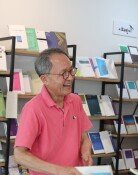The Wallets of Those in Their 50s Are Clammed Shut
The Wallets of Those in Their 50s Are Clammed Shut
Posted April. 07, 2005 23:25,
Starting this year, Mrs. Kim (51, Hyoja-dong, Wansan-gu, Jeonju, Jeollabuk-do), a housewife, has decided to start restructuring consumption to reduce the monthly cost of living from 2,000,000 won to 1,500,000 won. She has substantially decreased the cost of living, which takes up half of the 4,000,000 won salary of her husband, who works at a medium-sized company. If you exclude the 500,000-won repayment of student loans for her children, the net cost of living is merely 1,000,000 won.
This year Mrs. Kim has even given up her annual trip with her husband, a tradition of 20 years, and has ceased going to the hairdresser. She personally dyes her hair with a 5,000-won dye.
Mrs. Kim said, Not knowing when my husband might leave his job, we have decided not to purchase anything that is not a necessity, and explained, It is not as if we do not have money for immediate needs, but when you consider preparation for old age we feel that we are already too late.
Since the beginning of the 2000s the middle-aged class in their 50s is not spending money. Due to the anxiety concerning the years after retirement, they are reducing consumption by a significant amount and increasing savings.
According to the investigation of the National Statistical Office, the recent propensity to consume, which displays the weight of consumption among disposable income, of those over 50 have dropped by a substantial margin.
Those between 50 and 54 had a propensity to consume of 82.9 percent in 2000, but this has dropped by 7.2 percent to 75.7 percent. In 2004 this index increased to 78.1 percent but this is due to a leaner wallet than a rise in consumption. Though consumer prices have increased by 3.6 percent, the monthly average disposable income of this class has increased from 2,764,000 won to 2,767,100 won, a mere 3,100 won (0.2 percent) increase.
The propensity to consume of those over 55 has also dropped from 76.1 percent in 2000 to 69.4 percent last year.
Mr. Park (56, Mok1-dong Yangcheon-gu Seoul), a former banker now operating a construction management company, has tripled his savings compared to six years ago when he was working at a bank.
He said, In this low-interest-rate era the desired savings amount to accumulate before retirement has increased heavily, and friends who are still working in an office have increased savings due to the insecurity that they might have to leave their jobs.
The yield of a one-year maturity deposit has dropped from 9.53 percent in 1996 to 3.55 percent recently. In 1996, if you deposited 300 million won in the bank you received a monthly interest of 1,989,400 won even after deducting taxes (16.5 percent). However, you receive only 734,800 won nowadays.
Shin Woon, deputy general manager of the department of research at the Bank of Korea, said, One of the reasons for Japans depression of over ten years was the decrease of consumption and the increase of savings, due to the anxiety concerning livelihood during old age diffusing to the younger generation, adding, There is a high probability that the thrift of the middle-aged class of Korea will persist for quite a while.
♦ Average Propensity to Consume
This is an index indicating how much of the income a household consumes. You divide the amount of consumption by the disposable income and express it in percentage. Disposable income is the total income after the deduction of non-consumption expenses such as taxes, national pension, interest, and insurance. The unconsumed portion of the disposable income is savings, so the sum total of the average propensity to consume and the household propensity to save is 100 percent.
Byong-Ki Lee Chang-Won Kim eye@donga.com changkim@donga.com







